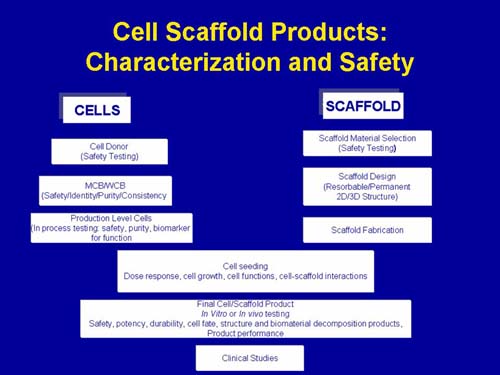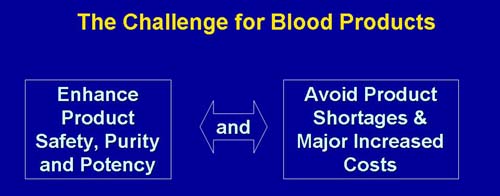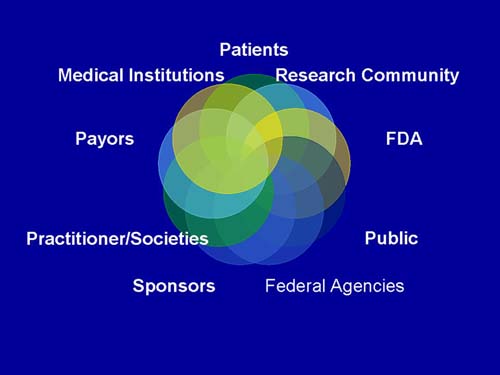CBER 2007
Celia Witten, Ph.D. MD
Office Director, Office of Cell Tissues and Gene Therapy, Center for Biologics Evaluation and Research, FDA
RAPS 2007 Annual Conference and Exhibition
September 24, 2007
Boston, Ma.
Outline
- CBER Overview
- Cellular, Tissue, and Gene Therapies
- Blood
- Vaccines
Vision for CBER
INNOVATIVE TECHNOLOGY ADVANCING PUBLIC HEALTH
- Protect and improve public and individual health in the US and, where feasible, globally
- Facilitate development, approval and access to safe and effective products and promising new technologies
- Strengthen CBER as a preeminent regulatory organization for biologics
Products Regulated by CBER
- Vaccines (preventative and therapeutic)
- Blood, blood components and derivatives
- Allergenics
- Cell and Gene Therapies
- Tissues
- Xenotransplantation Products
- Related Devices (including certain IVDs)
CBER’s Biological Products: Unique Issues/Needs for Science
- Made using or derived from living cells, tissues, or organisms:
- Inherent risks from product (e.g. live vaccine) and/or contamination
- Risk from new and emerging threats (natural, man-made)
- Complexity of manufacturing facilities/materials, processes and products
- Multiple mechanisms of action (not always predictable)
- Highest public concern for safety of critical products given to healthy individuals – vaccines (235 million), blood (30 million), tissues (>1 million)
- Unique roles in health care and national preparedness (pandemic, war/disaster, counterterrorism)
- Market incentives and, as a result, infrastructure, frequently weak for preventive measures and for emerging technologies and diseases
- New technologies important– high visibility/interest and complex risks
CBER Organization
- Immediate Office of Director
- Office of Blood Research and Review
- Office of Cellular, Tissue and Gene Therapies
- Office of Vaccines Research and Review
- Office of Compliance and Biologics Quality
- Office of Biostatistics and Epidemiology
- Office of Management
- Office of Communication, Training, and Manufacturer’s Assistance
FDA Collaboration/Outreach
- Product specific confidential enquires during pre-IND (IDE), IND (IDE) process
- Standards activities
- Guidance documents
- Advisory Committees: BPAC, TSEAC, CTGTAC, Vaccines, and Allergenic Products
- Site Visit Program (RSVP)
- Workshops
- Interagency and other collaborations Critical Path Initiative
Enhancing Product Safety
- Integrated approaches to early detection, analysis, action and communication
- Using all available technology, including health care databases
- Risk assessment/management and communication training plus special unit for complex issues/modeling
Office of Cellular, Tissue, and Gene Therapy
- Tissue and tissue based products
- Cellular therapies
- Tumor vaccines
- Gene therapies
- Xenotransplantation products
- Combination products
- Devices used for cells/tissues
- Anti-idiotype antibodies
Human Cells, Tissues, or Cellular or Tissue-Based Products (HCT/Ps)
Brief History of Tissue Regulation
- First tissue rule published in December 1993 in response to infectious disease concerns
- Legal Authority: Section 361 of Public Health Service (PHS) Act—prevent the introduction, transmission, or spread of communicable diseases
- Approach to regulation of Human Cells, Tissues, or Cellular or Tissue-Based Products (HCT/P)
- Tiered risk-based approach
- Broad scope of cells and tissues
- Implemented through rulemaking
Tissue Rules
21CFR1271, Effective May 25, 2005
- Establishment Registration
- Donor Eligibility
- Good Tissue Practices
- Not a premarket review program
“HCT/Ps”—Definition
- Articles containing or consisting of human cells or tissues that are intended for implantation, transplantation, infusion, or transfer to a human recipient
What is Included?
Human Cells, Tissues and Cellular and Tissue-based Products (HCT/Ps)
|
|
Not Included
- Vascularized human organs
- Minimally manipulated bone marrow
- Xenografts
- Blood products
- Secreted or extracted products; e.g., human milk, collagen, cell factors
- Ancillary products used in manufacture
- In vitro diagnostic products
- Blood vessels recovered with organs for use in organ transplantation
Current Activities
- Human Tissue Task Force (HTTF)
- recent release of report with recommendations
- MedSun Tissue and Cell Pilot Project
- surveillance for tissue & cell transplant adverse events
- >50 hospitals, >100 hospital personnel trained
- Transplantation Transmission Sentinel Network (TTSN)
- Tissue and organ common donor ID, adverse event reporting
- Collaboration with HRSA
- Advisory Committee on Organ Transplantation, policy issues
- PHS Advisory Committee on Blood Safety and Availability
- Expansion of Charter, includes tissues and organs
- Biovigilance focus
- International efforts (Eustite, DGSanco, WHO)
Workshop
- Public Workshop: Processing of Orthopedic, Cardiovascular, and Skin Allografts October 11-12, 2007
- http://www.fda.gov/cber/meetings/allog101107ag.htm
Guidance
- Guidance for Industry: Eligibility Determination for Donors of Human Cells, Tissues, and Cellular and Tissue-Based Products 2/27/07
Cellular Therapies
Cells: Examples of Indications/Sources
- Pancreatic islets for diabetes
- Stem and skeletal muscle progenitor cells for ischemic cardiac disease
- Hematopoietic reconstitution in treatment of malignancies
- Stem cells for metabolic storage diseases
- Stem cells for CNS indications (Parkinson’s disease)
- Expanded autologous cartilage for joint repair
Cellular Therapies: Challenges
- Autologous/allogeneic
- Single (or small) lot
- Cell banks (limited size and cell passage)
- Characterization/biological activity
- Contaminating cells
- Adventitious agents
- Cell fate post transplant
Outreach and Collaboration with Cellular Therapy Community
Conferences and Workshops
|
Liaison & MOU Activities
|
Cellular Therapies: Recent Draft Guidances
- Draft Guidance for Industry: Cell Selection Devices for Point of Care Production of Minimally Manipulated Autologous Peripheral Blood Stem Cells (PBSCs) 7/23/07
- Draft Guidance for Industry: Preparation of IDEs and INDs for Products Intended to Repair or Replace Knee Cartilage 7/6/07
- Draft Guidance for Industry: Minimally Manipulated, Unrelated, Allogeneic Placental/Umbilical Cord Blood Intended for Hematopoietic Reconstitution in Patients with Hematological Malignancies 1/16/07
Gene Therapy Characterization and Safety
Gene Therapies
- Transferred directly to the subject or ex vivo modified cells administered to subjects
- Gene Therapy Vectors
- Plasmid
- Adenovirus
- Adeno-associated virus
- Retrovirus & Lentivirus
- Poxvirus
- Herpesvirus
- Bacteria
Special Considerations for Gene Therapy
- Vector Toxicity-inherent risk for some vectors
- Potential to permanently modify genome
- Risk of uncontrolled transgene expression
- Insertional Mutagenesis
- Germline alteration-risk to future generations
- Potential to spread viral vectors from patient to the environment
- Medical professionals
- Household members
- Public at large
Outreach, collaborations, scientific discussions
- NTP study to assess preclinical safety model for retroviral vector-mediated insertional tumorigenesis
- NIH Recombinant DNA Advisory Committee
- ICH Gene Therapy Discussion Group
- WHO Monitoring Group on Gene Transfer Medicinal Products
Guidance
- Guidance for Industry: Gene Therapy Clinical Trials-Observing Subjects for Delayed Adverse Events 11/28/06
- Supplemental Guidance on Testing for Replication Competent Retrovirus in Retroviral Vector Based Gene Therapy Products and During Follow-up of Patients in Clinical Trials Using Retroviral Vectors
Reference Materials
- Retrovirus reference material
- Adenovirus reference material
- RNA spike-in controls
- Fluorescent standard solution
- Fluorescent microbead standard
Cell-Scaffold Products
Cell Scaffold Products: Characterization and Safety

Regulation of Regenerative Medicine Products
- Guidances for Cellular, Gene Therapies, and Devices
- Leveraging existing guidances to support specific areas of tissue engineered medical products
- CMC guidances for cellular products
- General (CT and GT) preclinical guidances
- Guidances for devices may be applicable to scaffolds
- Many clinical guidances cross-cut product areas
CBER/CDRH Tissue Engineering Cross-Center Teams
- Facilitate intercenter co-operation and solutions of TE issues
- Provide a core resource of TE review expertise to CBER, CDRH, OCP
- Participate in development of regulatory policy and pathways
- Facilitate FDA participation in Standards Organizations
- Provide a strong, consistent FDA voice in outreach activities with academia, industry, other governmental programs
- Provide an educational resource for reviewers within CBER and CDRH
Collaboration and Outreach
- MATES/Strategic Plan
- FDA/NIST Workshop: “In Vitro Analyses of Cell-Scaffold Products” December 6-7
- Liaison meeting with Tissue Engineering Regenerative Medicine Centers
- ASTM TEMPS
Upcoming FDA Public Workshops
- Processing of Orthopedic, Cardiovascular, and Skin Allografts
- October 11-12, 2007
- NIH, Bethesda, MD
- http://www.fda.gov/cber/meetings/allog101107.htm
- In Vitro Analyses of Cell/Scaffold Medical Products
- December 6-7, 2007
- NTSB Conference Center, Washington, DC
- http://www.fda.gov/cber/meetings/invitro120607.htm
Hot Topics Related to Blood and Tissue Safety
- Blood and plasma components
- Plasma derivatives
- Donor screening tests to prevent infections
- Blood grouping reagents to assure safe transfusion
- Devices used in collection, storage and processing
- Blood bank and related computer software
- HIV diagnostic tests
The Challenge for Blood Products

Protect and improve blood safety, efficacy and availability while working to prevent disruptions to the blood supply
- Newly formed CBER-wide Blood Safety Team to enhance timely & medically sound evaluation of epidemiological information, BPD reports, potential shortages, and other intelligence
Hot Topics Related to Blood and Tissue Safety
- Guidance on NAT for HIV-1 and HCV
- Donor testing for WNV: ID versus MP-NAT
- Geographic/seasonal variations
- Donor testing for Chagas’ Disease
- T.Cruzi is transmissible by transfusion
- T.Cruzi is endemic in portions of Mexico, Central America, and South America
- Prevalence in US is due to immigration from endemic regions
- Chronically infected donors are asymptomatic
- vCJD risk assessment for plasma derivatives
- Risk communication on plasma-derived FVIII and FIX
Selected New Product Approvals
- Abbott Prism for detection of anti-HCV
- Procleix Ultrio Assay for HIV-1, HCV and HBV with fully automated TIGRIS system
- Ortho T. cruzi ELISA for donor screening
- Baxter CEPROTIN (protein C concentrate for deficiency)
- Cangene HBIG to prevent HBV after OLT
- Grifols and CSL Behring AHF/vWF products for surgical indications in VWD
- Novo Nordisk rFVIIa for surgical indications in acquired hemophilia
- Omrix fibrin sealant for hemostasis in vascular surgery
- CSL Behring Rho(D) for chronic ITP in Rho(D)+/non-splenectomized patients
- APTIMA HIV-1 RNA Qualitative Assay for HIV diagnosis
Selected New Product Approvals
- Abbott Prism for detection of anti-HCV
- Procleix Ultrio Assay for HIV-1, HCV and HBV with fully automated TIGRIS system
- Ortho T. cruzi ELISA for donor screening
- Baxter CEPROTIN (protein C concentrate for deficiency)
- Cangene HBIG to prevent HBV after OLT
- Grifols and CSL Behring AHF/vWF products for surgical indications in VWD
- Novo Nordisk rFVIIa for surgical indications in acquired hemophilia
- Omrix fibrin sealant for hemostasis in vascular surgery
- CSL Behring Rho(D) for chronic ITP in Rho(D)+/non-splenectomized patients
- APTIMA HIV-1 RNA Qualitative Assay for HIV diagnosis
Blood Related Guidance Published in FY’07
- Biological Product Deviation Reporting for Blood and Plasma Establishments
- Implementation of Acceptable Full-Length Donor History Questionnaire and Accompanying Materials for Use in Screening Donors of Blood and Blood Components
- Informed Consent Recommendations for Source Plasma Donors Participating in Plasmapheresis and Immunization Programs
- Guidance for Industry: Adequate and Appropriate Donor Screening Tests for Hepatitis B; Hepatitis B Surface Antigen (HBsAg) Assays Used to Test Blood, Blood Components and Source Plasma Donations
- Draft Guidance for Industry: “Computer Crossmatch”
Continuing public dialogue to enhance product safety and availability
- Workshops 2006
- Behavior-based deferrals in the NAT era, 3/06
- Donor testing for malaria, 7/06
- Molecular methods in immunohematology, 9/06
- Immune Globulin Antibody Specificities and Potency, 4/07
- Workshops under development for 2007
- Apheresis Licensure, 8/07
- Regulation of BECS, 9/07
- Participation with other HHS components on IGIV availability
Current HHS Initiatives: Biovigilance
- Consistent with recommendations of the HHS Advisory Committee for Blood Safety and Availability, HHS has established an inter-agency working group on “biovigilance”
- The charge of the working group is to develop strategies to integrate and improve safety surveillance and novel event detection for transfusion and transplantation
- The working group is developing a “gap analysis”
- A principal goal is to clarify the respective roles of federal agencies and the private sector in “biovigilance”
Disaster Management and Preparedness
- AABB Interorganizational Disaster Task Force
- Designated in ESF-8 of NRP for emergency blood supply coordination
- Level 1 members convene by telephone conference within one hour of an event (including representatives from affected blood establishments)
- Level 1 includes all major blood organizations, HHS, FDA, CDC, DOD
- TF has been active in TOPOFF exercises, as well as proactive planning for large events (political conventions, superbowl, etc)
- AABB Pandemic Influenza Task Force
- Proactive pandemic planning over past two years
- Task Force has proposed FDA regulatory flexibility during pandemic-related shortages (Wide range of regulatory flexibilities proposed to FDA)
- AABB has urged FDA to be transparent regarding its intentions so as to allow planning by the blood community
Safety Teams
- Integrated safety teams (e.g., epidemiologists, clinical/product reviewers, compliance/inspectional activities, communications) in all product areas to improve acquisition and utilization of safety information
- Surveillance/follow-up on adverse event reports
- Encompass entire product life cycle and all data relevant to safety, manufacturing and compliance
- Active use of health care databases
- Proactive: set research, policy & outreach agendas
- Coordinate center response to emerging safety issues with other FDA Centers and HHS agencies, industry
- Tissue Safety Team and Blood Safety Team operational, Vaccine Safety Team in 07
- Cooperation with “biovigilance” initiative in HHS and “hemovigilance” initiative of AABB
Blood-Related Standards and Reference Materials
- Coagulation and other proteins (many collaborative with WHO, NIBSC, others):
- Factor VIII, thrombin, α1-PI, IGIV and HBIG (anti-measles, polio, HBs), pre-kallikrein activator, anti-D, anti-A and anti-B hemagglutinins (w/ NIBSC, EDQM)
- Infectious agents
- Nucleic acids: HIV-1 subtypes, HIV-2, HAV, HBV genotypes, HCV genotypes, B19, malaria
- Antibodies: HTLV, anti-HBc, anti-HBs, monospecific anti-HCV,
- Blood group substances
- CBER Panels: WNV, HIV subtypes, Chagas
Global Harmonization and Collaboration: Examples
- WHO Collaborating Center
- Expert Committee for Biological Standards
- Blood Regulators Network
- Collaboration on Development of Biological Reference Preparations for High-risk Blood Safety-related in vitro Diagnostics
- International Conference of Drug Regulatory Authorities
- WHO Global Collaboration for Blood Safety
- ICH, PIC-S, SoGAT, ISBT Working Party for TTIDs
- Council of Europe
- EDQM
- Alliance of Blood Operators
Vaccines
Recent Vaccine Approvals
- 2007
- H5N1 (Sanofi Pasteur)
- 2006
- Rotavirus Vaccine (Rota Tec)
- Herpes Zoster Vaccine (Zostavax)
- Human Papillomavirus Vaccine (Gardasil)
- Influenza Trivalent Vaccine (FluLaval)
Major Vaccine Initiatives
- Pandemic influenza and emerging threat preparedness
- Enhancing Product Safety
- Manufacturing and Product quality activities
- Global Collaboration
Pandemic Influenza
- Build review and testing capacity—including for surge and new vaccine technologies (e.g. adjuvanted, recombinant, or cell-culture grown vaccines)
- Influenza virus strain and reagent preparation needed for vaccine manufacture and testing
- Improved assays for evaluating vaccine potency, immune responses, etc.
- Support DHHS planning and vaccine development activities—enhance emergency vaccine availability preparedness
Manufacturing and Product Quality Initiatives
- New CBER laboratories in newly created Division of Product Quality
- Quality environment for critical product testing and standards activities
- Ongoing efforts toward ISO certification
- Research to modernize approaches
- Develop/evaluate more rapid potency and other lot release and product characterization assays
- Enhanced methods to measure immune responses
Global Collaboration
- Leadership role of FDA, together with WHO and Health Canada, in Pandemic Influenza Vaccine Regulators Initiative
- Develop convergence on data needed to evaluate pandemic influenza vaccines
- Regulators meetings held in 2006 and June 2007
- ECBS will be considering these draft guidelines later in 2007 to work toward finalization of document
Guidances
- Guidance for Industry: Clinical Data Needed to Support the Licensure of Pandemic Influenza Vaccines 5/31/07
- Guidance for Industry: Clinical Data Needed to Support the Licensure of Seasonal Inactivated Influenza Vaccines 5/31/07
- Draft Guidance for Industry: Characterization and Qualification of Cell Substrates and Other Biological Starting Materials Used in the Production of Viral Vaccines for the Prevention and Treatment of Infectious Diseases 9/28/06

Contact Information
Celia Witten, PH.D., M.D.
Office Director, OCTGT
CBER/FDA
1401 Rockville Pike (HFM 700)
Rockville, MD 20852-1448
Celia.witten@fda.hhs.gov
301-827-5102


